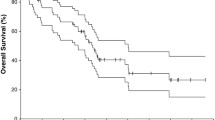Abstract
The aim of this study was to evaluate the clinical impact of the preoperative 18F-FDG PET/CT in the initial workup of breast cancer with clinically negative axillary nodes. Whether the status of the clinical axillary nodal involvement can be considered a parameter for making a decision to omit the preoperative 18F-FDG PET/CT in the situation reported herein was also determined. A total of 178 patients who had newly diagnosed breast cancer and for whom the conventional diagnostic modalities showed no sign of axillary node metastasis were retrospectively enrolled in this study. All the patients underwent preoperative 18F-FDG PET/CT. The images and histologic results that were obtained were analyzed. 18F-FDG PET/CT detected primary lesions in 156 of the 178 patients, with an overall sensitivity of 87.6 %, and false negative results were obtained for 22 patients (12.4 %). The sensitivity, specificity, positive predictive value, negative predictive value, and accuracy of 18F-FDG PET/CT in the detection of axillary nodes were 20.8, 86.9, 37.0, 74.8, and 69.1 %, respectively. Extra-axillary node metastasis was identified in two patients (1.1 %) who had internal mammary nodes. There was no distant metastasis, but coexisting primary tumor was detected in five patients (2.8 %). In total, the therapeutic plan was changed based on 18F-FDG PET/CT in seven (3.9 %) of the 178 patients, but considering only the cases confined to breast cancer, the change occurred in only two patients (1.1 %). 18F-FDG PET/CT almost did not affect the initial staging and treatment plan in breast cancer with clinically negative axillary node. If the axillary node is clinically negative in the preoperative workup of breast cancer, then 18F-FDG PET/CT can be omitted.

Similar content being viewed by others
References
Norum J, Andreassen T (2000) Screening for metastatic disease in newly diagnosed breast cancer patients. What is cost-effective? Anticancer Res 20:2193–2196
Kataja V, Castiglione M (2009) Primary breast cancer: ESMO clinical recommendations for diagnosis, treatment and follow-up. Ann Oncol 20(Suppl 4):10–14
Hegarty C, Collins CD (2010) PET/CT and breast cancer. Cancer Imaging 10:S59–S62
Choi YJ, Shin YD, Kang YH, Lee MS, Lee MK, Cho BS et al (2012) The effects of preoperative 18F-FDG PET/CT in breast cancer patients in comparison to the conventional imaging study. J Breast Cancer 15:441–448
Lee JH (2013) Radionuclide methods for breast cancer staging. Semin Nucl Med 43:294–298
Segaert I, Mottaghy F, Ceyssens S, De Wever W, Stroobants S, Van Ongeval C et al (2010) Additional value of PET-CT in staging of clinical stage IIB and III breast cancer. Breast J 16:617–624
Groheux D, Espié M, Giacchetti S, Hindié E (2013) Performance of FDG PET/CT in the clinical management of breast cancer. Radiology 266:388–405
Cooper KL, Harnan S, Meng Y, Ward SE, Fitzgerald P, Papaioannou D et al (2011) Positron emission tomography (PET) for assessment of axillary lymph node status in early breast cancer: A systematic review and meta-analysis. Eur J Surg Oncol 37:187–198
Seok JW, Kim Y, An YS, Kim BS (2013) The clinical value of tumor FDG uptake for predicting axillary lymph node metastasis in breast cancer with clinically negative axillary lymph nodes. Ann Nucl Med 27:546–553
Groves AM, Shastry M, Ben-Haim S, Kayani I, Malhotra A, Davidson T et al (2012) Defining the role of PET-CT in staging early breast cancer. Oncologist 17:613–619
Bernsdorf M, Berthelsen AK, Wielenga VT, Kroman N, Teilum D, Binderup T et al (2012) Preoperative PET/CT in early-stage breast cancer. Ann Oncol 23:2277–2282
Garami Z, Hascsi Z, Varga J, Dinya T, Tanyi M, Garai I et al (2012) The value of 18-FDG PET/CT in early-stage breast cancer compared to traditional diagnostic modalities with an emphasis on changes in disease stage designation and treatment plan. Eur J Surg Oncol 38:31–37
Jatoi I, Hilsenbeck SG, Clark GM, Osborne CK (1999) Significance of axillary lymph node metastasis in primary breast cancer. J Clin Oncol 17:2334–2340
Veronesi U, De Cicco C, Galimberti VE, Fernandez JR, Rotmensz N, Viale G et al (2007) A comparative study on the value of FDG-PET and sentinel node biopsy to identify occult axillary metastases. Ann Oncol 18:473–478
Danforth DN Jr, Aloj L, Carrasquillo JA, Bacharach SL, Chow C, Zujewski J et al (2002) The role of 18F-FDG-PET in the local/regional evaluation of women with breast cancer. Breast Cancer Res Treat 75:135–146
Hodgson NC, Gulenchyn KY (2008) Is there a role for positron emission tomography in breast cancer staging? J Clin Oncol 26:712–720
Koolen BB, Valdés Olmos RA, Elkhuizen PH, Vogel WV, Vrancken Peeters MJ, Rodenhuis S et al (2012) Locoregional lymph node involvement on 18F-FDG PET/CT in breast cancer patients scheduled for neoadjuvant chemotherapy. Breast Cancer Res Treat 135:231–240
Ng AK, Travis LB (2008) Second primary cancers: an overview. Hematol Oncol Clin North Am 22:271–289
Avril N, Menzel M, Dose J, Schelling M, Weber W, Jänicke F et al (2001) Glucose metabolism of breast cancer assessed by 18F-FDG PET: histologic and immunohistochemical tissue analysis. J Nucl Med 42:9–16
Acknowledgments
This work was supported by the Dong-A University research fund.
Conflict of interest
The authors declare that they have no conflict of interest
Author information
Authors and Affiliations
Corresponding author
Rights and permissions
About this article
Cite this article
Jeong, Y.J., Kang, DY., Yoon, H.J. et al. Additional value of F-18 FDG PET/CT for initial staging in breast cancer with clinically negative axillary nodes. Breast Cancer Res Treat 145, 137–142 (2014). https://doi.org/10.1007/s10549-014-2924-8
Received:
Accepted:
Published:
Issue Date:
DOI: https://doi.org/10.1007/s10549-014-2924-8




